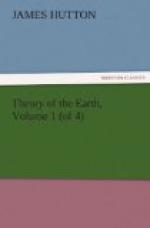It has been in reasoning after this manner, that I have endeavoured to prove, that every thing which we now behold, of the solid parts of this earth, had been formerly at the bottom of the sea; and that there is, in the constitution of this globe, a power for interchanging sea and land. If this shall be admitted as a just view of the system of this globe, we may next examine, how far there are to be found any marks of certain parts of our earth having more than once undergone that change of posture, or vicissitude of things, and of having had reiterated operations of the mineral kingdom changing their substance, as well as altering their positions in relation to the atmosphere and sea.
Besides the gradual decay of solid land, exposed to the silent influences of the atmosphere, and to the violent operations of the waters moving upon the surface of the earth, there is a more sudden destruction that may be supposed to happen sometimes to our continents of land. In order to see this, it must be considered, that the continents of our earth are only raised above the level of the sea by the expansion of matter, placed below that land, and rarified in that place: We may thus consider our land as placed upon pillars, which may break, and thus restore the ancient situation of things when this land had been originally collected at the bottom of the ocean. It is not here inquired by what mechanism this operation is to be performed; it is certainly by the exertion of a subterranean power that the land is elevated from the place in which it had been formed; and nothing is more natural than to suppose the supports of the land in time to fail, or be destroyed in the course of mineral operations which are to us unknown. In that case, whatever were remaining of that land, which had for millions of ages past sustained plants and animals, would again be placed at the bottom of the sea; and strata of every different species might be deposited again upon that mass, which, from an atmospheric situation, is now supposed to be lower than the surface of the sea.
Such a compound mass might be again resuscitated, or restored with the new superincumbent strata, consolidated in their texture and inclined in their position. In that case, the inferior mass must have undergone a double course of mineral changes and displacement; consequently, the effect of subterranean heat or fusion must be more apparent in this mass, and the marks of its original formation more and more obliterated.
If, in examining our land, we shall find a mass of matter which had been evidently formed originally in the ordinary manner of stratification, but which is now extremely distorted in its structure, and displaced in its position,—which is also extremely consolidated in its mass, and variously changed in its composition,—which therefore has the marks of its original or marine composition extremely obliterated, and many subsequent veins of melted mineral




